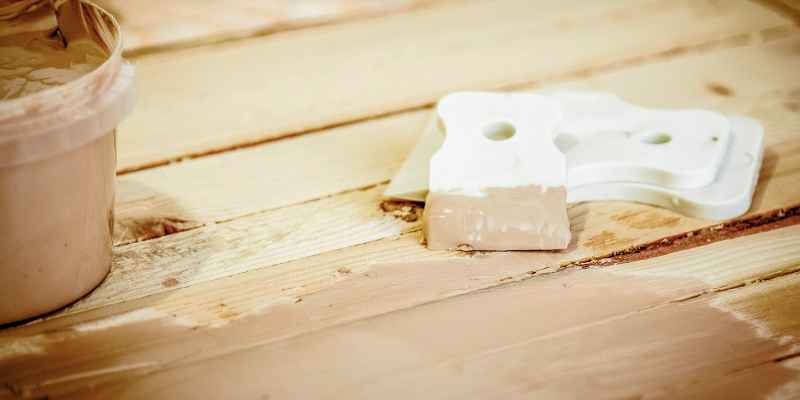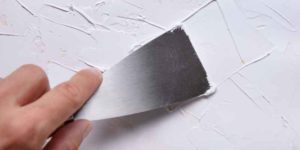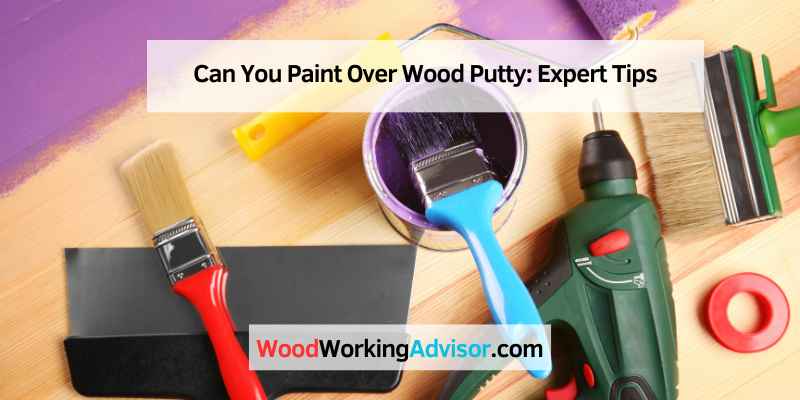Yes, you can paint over wood putty. Wood putty can be painted to match the surrounding wood after repairing cracks or holes in furniture, flooring, or other interior woodwork.
It is important to check the packaging of the wood filler to determine if it is stainable or not, as this can affect how well it holds color when painted. Water-based or solvent-based wood fillers typically hold stain well, while oil-based fillers may not hold color as effectively.
To ensure an even appearance, using primer before painting is recommended, especially when painting a larger area or furniture that has been repaired with wood putty.
Understanding Wood Putty
Wood putty can be painted over after repairing cracks or holes in woodwork. Ensure the putty is stainable if needed for a seamless finish, as some may not hold color well with paint. Applying a primer before painting over wood putty can help achieve a uniform look.
Composition Of Wood Putty
Wood putty is a versatile material that is commonly used for repairing imperfections in wood surfaces. It is composed of a combination of binder, filler, and solvent. The binder, which is usually a drying oil like linseed oil, holds the putty together and provides adhesion. Fillers, such as sawdust or wood fibers, are added to give the putty the necessary bulk. Solvents, such as mineral spirits, are used to adjust the consistency of the putty and allow for easy application.
Types Of Wood Putty
There are different types of wood putty available in the market, each with its own unique characteristics. Here are a few common types:
- Oil-Based Wood Putty: This type of wood putty is made with oil-based binder and is known for its durability and resistance to shrinking or cracking. It is ideal for outdoor applications as it can withstand the elements.
- Water-Based Wood Putty: This type of wood putty is made with a water-based binder and is more environmentally friendly. It is easy to clean up and dries quickly, making it suitable for indoor use.
- Epoxy Wood Putty: Epoxy wood putty is a two-part putty that consists of a resin and a hardener. When mixed together, these two components create a strong and durable putty that can be used for both indoor and outdoor projects. It can also be sanded and shaped easily.
Before choosing a wood putty for your project, consider the specific requirements and conditions it will be exposed to. This will help you select the most appropriate type of wood putty for the job.
Understanding the composition and types of wood putty is essential when it comes to painting over it. Now that we have discussed the composition and types of wood putty, let’s dive into the process of painting over it and whether it is a viable option.

Factors To Consider Before Painting Over Wood Putty
Before painting over wood putty, there are several factors that you should consider. Proper surface preparation and choosing the right paint are crucial to achieving a smooth and durable finish. In this section, we will discuss these factors in detail and provide you with valuable insights to ensure a successful painting project.
Surface Preparation
Surface preparation is the key to a long-lasting paint job when it comes to painting over wood putty. Here are some important steps to follow:
- Start by cleaning the surface thoroughly to remove any dirt, grease, or debris. You can use a mild detergent and water solution for this purpose.
- Next, sand the area around the wood putty to create a smooth and even surface. Use fine-grit sandpaper and work in the direction of the wood grain.
- After sanding, wipe off any dust with a clean cloth or tack cloth.
- If there are any cracks or gaps in the wood putty, fill them with additional putty and smooth the surface with a putty knife.
- Finally, make sure the surface is completely dry before proceeding to the next step.
Choosing The Right Paint
Choosing the right paint is essential for a successful painting project over wood putty. Here are some factors to consider:
- Opt for a high-quality paint that is recommended for wood surfaces. Look for paint specifically designed for trim or furniture.
- Consider the type of finish you desire, such as matte, satin, or gloss. Keep in mind that certain finishes may be more forgiving in hiding imperfections.
- Check the paint label for compatibility with wood putty. Some paints may not adhere well to certain types of putty.
- If you plan to stain the wood putty, choose a paint that is stainable to ensure a seamless and consistent finish.
- Additionally, consider the paint’s durability and resistance to moisture, especially if the painted surface will be exposed to outdoor elements.
Application Of Paint On Wood Putty
When it comes to the application of paint on wood putty, it’s essential to follow specific steps to achieve a smooth and durable finish. Properly painting over wood putty can enhance the overall look of woodwork, furniture, or any surface that requires repair and refinishing. Let’s explore the necessary steps and techniques to ensure a successful painting process.
Priming The Surface
Before applying paint over wood putty, it’s crucial to prime the surface to ensure proper adhesion and a uniform finish. Using a high-quality wood primer will help seal the putty and create a suitable base for the paint to adhere to. Ensure that the primer is compatible with the type of paint you intend to use for the best results.
Painting Techniques
When it comes to painting over wood putty, employing the right techniques can make a significant difference in the final outcome. Consider using smooth and even brush strokes to apply the paint, ensuring complete coverage of the repaired area. Layering the paint thinly and evenly can help in achieving a seamless blend with the surrounding wood.
Common Issues And Solutions
Painting over wood putty is definitely possible. After repairing any cracks or holes in the wood, the putty can be painted to match the surrounding wood. Just ensure that the wood filler you use is paintable, as some may not hold color well when painted.
Bleeding Through The Paint
When painting over wood putty, one common issue is bleeding through the paint. This occurs when the putty’s color seeps into the paint, causing discoloration. To prevent this, apply a primer before painting to create a barrier.
Adhesion Problems
If you encounter adhesion problems when painting over wood putty, the paint may not stick properly. To solve this, ensure the putty is completely dry before painting and lightly sand the area to improve adhesion.
Tips For Achieving A Smooth Finish
I can help you write a piece on “Can You Paint Over Wood Putty” with essential tips for achieving a smooth finish. Wood putty can be painted after repairing gouges and cracks in exterior woodwork. The key is to use a primer and choose a paint that complements the putty.
It is necessary to check whether the putty is suitable for painting or staining.
Sanding Techniques
Proper sanding of wood putty is crucial for a smooth finish.
Application Of Sealants
Sealants play a vital role in ensuring the longevity of your paint job over wood putty.
Special Considerations For Different Types Of Wood Putty
When it comes to painting over wood putty, it’s essential to consider the type of putty being used. Different types of wood putty have specific characteristics that can influence the painting process. Understanding these variations can help ensure a successful and long-lasting paint job. Let’s delve into the special considerations for different types of wood putty, including stainable wood putty and the differences between oil-based and water-based wood putty.
Stainable Wood Putty
Stainable wood putty is designed to accept wood stains, allowing it to blend seamlessly with the surrounding wood surface. When choosing a stainable wood putty, it’s important to verify its compatibility with the intended wood stain. Additionally, ensuring that the wood putty is adequately cured before applying the stain is crucial to achieving a uniform and attractive finish.
Oil-based Vs. Water-based Wood Putty
Oil-based and water-based wood putties each have distinct properties that can impact their paintability. Oil-based wood putty tends to be more resistant to shrinking and cracking, making it a suitable option for exterior applications. However, when it comes to painting over oil-based wood putty, it’s essential to use oil-based paints for optimal adhesion and durability.
Conversely, water-based wood putties offer ease of use and cleanup, making them ideal for interior projects. If painting over water-based wood putty, it’s crucial to use compatible paint products, such as latex or acrylic paints, to achieve a smooth and long-lasting finish.

Frequently Asked Questions Of Can You Paint Over Wood Putty
Is Wood Putty Paintable?
Yes, wood putty is paintable. After using it to repair cracks or holes, you can paint over it to match the surrounding wood.
Can You Paint Or Stain Over Wood Putty?
Yes, you can paint over wood putty. Make sure the wood putty is stainable or water-based for best results. If it’s oil-based, it may not hold the color well when painted. Use primer before painting to even out the look.
Can You Paint Over Putty?
Yes, you can paint over wood putty to match surrounding wood or furniture, ensuring the putty is paintable.
Can You Paint Straight Onto Wood Filler?
Yes, most wood fillers can be painted onto, but may affect the paint appearance. Using primer first can help even out the look.
Conclusion
When it comes to painting over wood putty, it is important to choose a product that is paintable. Most wood fillers can be painted, but it’s crucial to consider the type of filler being used. It’s also recommended to use a primer before painting to ensure an even finish.
Whether you are repairing gouges on exterior woodwork or fixing chips in finished furniture, wood putty can be a reliable solution. Just make sure to check the packaging for information on whether it is stainable or suitable for painting.


